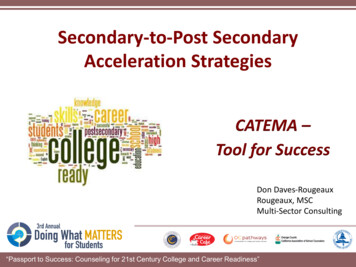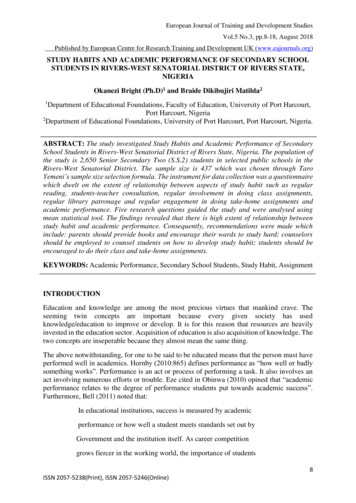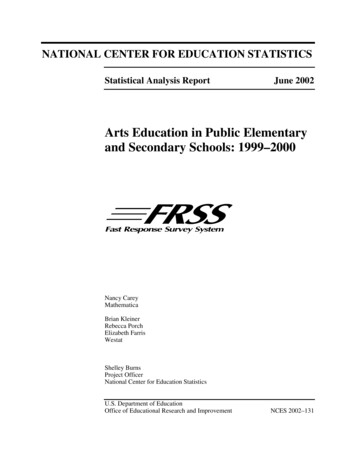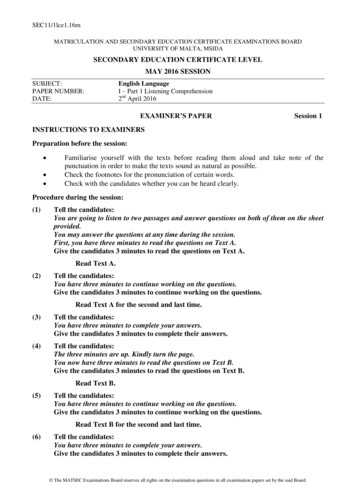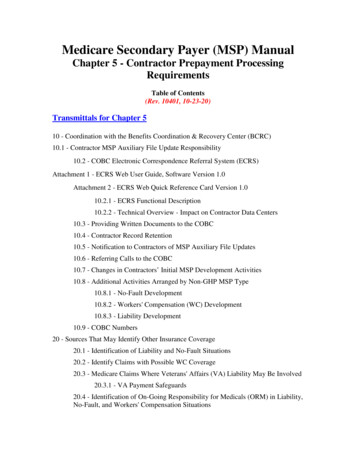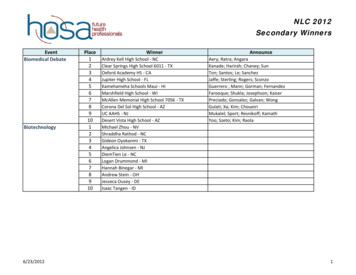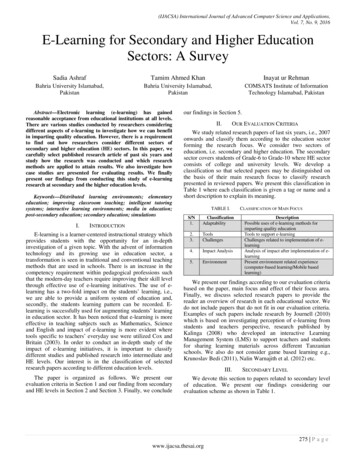
Transcription
(IJACSA) International Journal of Advanced Computer Science and Applications,Vol. 7, No. 9, 2016E-Learning for Secondary and Higher EducationSectors: A SurveySadia AshrafTamim Ahmed KhanInayat ur RehmanBahria University Islamabad,PakistanBahria University Islamabad,PakistanCOMSATS Institute of InformationTechnology Islamabad, PakistanAbstract—Electronic learning (e-learning) has gainedreasonable acceptance from educational institutions at all levels.There are various studies conducted by researchers consideringdifferent aspects of e-learning to investigate how we can benefitin imparting quality education. However, there is a requirementto find out how researchers consider different sectors ofsecondary and higher education (HE) sectors. In this paper, wecarefully select published research article of past six years andstudy how the research was conducted and which researchmethods are applied to attain results. We also investigate howcase studies are presented for evaluating results. We finallypresent our findings from conducting this study of e-learningresearch at secondary and the higher education levels.Keywords—Distributed learning environments; elementaryeducation; improving classroom teaching; intelligent tutoringsystems; interactive learning environments; media in education;post-secondary education; secondary education; simulationsI.INTRODUCTIONE-learning is a learner-centered instructional strategy whichprovides students with the opportunity for an in-depthinvestigation of a given topic. With the advent of informationtechnology and its growing use in education sector, atransformation is seen in traditional and conventional teachingmethods that are used in schools. There is an increase in thecompetency requirement within pedagogical professions suchthat the modern-day teachers require improving their skill levelthrough effective use of e-learning initiatives. The use of elearning has a two-fold impact on the students’ learning, i.e.,we are able to provide a uniform system of education and,secondly, the students learning pattern can be recorded. Elearning is successfully used for augmenting students’ learningin education sector. It has been noticed that e-learning is moreeffective in teaching subjects such as Mathematics, Scienceand English and impact of e-learning is more evident wheretools specific to teachers’ everyday use were utilized Cox andBritain (2003). In order to conduct an in-depth study of theimpact of e-learning initiatives, it is important to classifydifferent studies and published research into intermediate andHE levels. Our interest is in the classification of selectedresearch papers according to different education levels.The paper is organized as follows. We present ourevaluation criteria in Section 1 and our finding from secondaryand HE levels in Section 2 and Section 3. Finally, we concludeour findings in Section 5.II.OUR EVALUATION CRITERIAWe study related research papers of last six years, i.e., 2007onwards and classify them according to the education sectorforming the research focus. We consider two sectors ofeducation, i.e. secondary and higher education. The secondarysector covers students of Grade-6 to Grade-10 where HE sectorconsists of college and university levels. We develop aclassification so that selected papers may be distinguished onthe basis of their main research focus to classify researchpresented in reviewed papers. We present this classification inTable 1 where each classification is given a tag or name and ashort description to explain its meaning.TABLE es4.Impact Analysis5.EnvironmentCLASSIFICATION OF MAIN FOCUSDescriptionPossible uses of e-learning methods forimparting quality educationTools to support e-learningChallenges related to implementation of elearningAnalysis of impact after implementation of elearningPresent environment related experience(computer-based learning/Mobile basedlearning)We present our findings according to our evaluation criteriabased on the paper, main focus and effect of their focus area.Finally, we discuss selected research papers to provide thereader an overview of research in each educational sector. Wedo not include papers that do not fit in our evaluation criteria.Examples of such papers include research by Journell (2010)which is based on investigating perception of e-learning fromstudents and teachers perspective, research published byKalinga (2008) who developed an interactive LearningManagement System (LMS) to support teachers and studentsfor sharing learning materials across different Tanzanianschools. We also do not consider game based learning e.g.,Krunoslav Bedi (2011), Nalin Warnajith et al. (2012) etc.III.SECONDARY LEVELWe devote this section to papers related to secondary levelof education. We present our findings considering ourevaluation scheme as shown in Table 1.275 P a g ewww.ijacsa.thesai.org
(IJACSA) International Journal of Advanced Computer Science and Applications,Vol. 7, No. 9, 2016A. AdaptabilityKiilu Redempta (2012) examined Kenyan schools to findout if schools were ready and if they showed a positive attitudetowards the adoption of e-learning. He conducted a desktopreview supported by Current Situation Analysis (CSA). Heconcludes that less than 10% of Kenyan schools offer computerscience as a subject in the curriculum, The current educationalpractices neglect e-readiness. Mildred A. Ayere (2010)presented a case study of New Partnership for Africa’sDevelopment (NEPAD) schools of Kenya. These schools weredeveloped to integrate ICT and they are compared with theones that are not implementing NEPAD. We call them NonNEPAD schools. Twelve schools participated in the researchwhere six NEPAD and remaining Non-NEPAD schools areselected. The researchers select NEPAD schools throughsaturated sampling whereas they select Non-NEPAD schoolsthrough random sampling. The research is a combination ofexploratory approach using descriptive survey and ex-postfacto design with questionnaire as the main data collectioninstrument along with interviews involving students, principalsand heads of departments. The authors use descriptive andinferential statistics for data analysis and do a comparison ofboth types of schools concluding that teachers should be fullyfacilitated and their roles should be strengthen in schools whichoffer ICT education. Glushkova (2012) used Sharable ContentObject Reference Model (SCORM) standard templates andmodified them to create e-lessons. The underlying approach inSCORM is a combination of stereotypical and overlay modelswhich not only benefited students in terms of providing betterguidance and distance learning but also helped special students.Neyland (2011) investigated factors associated withintegration of online learning in Sydney high schools. Theresearch is carried out by conducting interviews andquestionnaires in New South Wales secondary schools. Theauthors conclude that school support and the micro factors suchas teacher capabilities are important.B. ToolsHsien-Sheng Hsiao, Lin, and Lin (2012) proposed a selfregulated web quest learning method for Chinese secondaryschools with the aim of examining correlation betweenstudents’ self-regulated behavior and their achievements. Theproposed web quest learning was based on self-regulatedlearning assisted functions and traditional web quest learning.The experiment was conducted on sixth grade students andresults were analyzed by observing their self-regulatedbehavior as well as system records collected during in thelearning process. The results showed that the presented systemassisted students in learning and helped teachers in monitoringstudents’ performance. Wei-wei Feng (2010) targeted Chinesesecondary schools in Hong Kong and analyzed benefits of elearning in teachers’ training and emphasized importance of eportfolio as a learning and assessment tool for teacherstraining. According to the authors, use of e-learning couldmake in-service training more easy and learning process couldbe made more transparent and innovative by applying eportfolio.C. ChallengesMicheuz (2007) focused on Austrian secondary academicschools to investigate how far e-learning technologies areestablished at this educational level. The research was carriedout with the help of online questionnaires and the authorsevaluated whether e-learning helped in learning and concludedthat it is still an unanswerable question since it faces manyobstacles like budget, teachers’ adoption, etc.D. Impact AnalysisHuan-Ming Chuang (2008) examined the impact ofKnowledge Sharing Blog (KSB) among three groups ofsecondary students. Authors divided students in groups suchthat one of the groups used e-learning with KSB, second usede-learning without KSB and the third group comprised of thosewho studied in the traditional classroom environment. Theresults concluded that students of the first group showedsignificant improvement in their learning as compared to theother two groups.E. EnvironmentChiu-Pin Lin et al. (2010) studied learning of social studiesand involved 6th-grade students to find out the impact ofcollaborative concept learning by having a comparativeanalysis of two different learning environments. In the firstenvironment, each student used a computer system for learningpurpose while in the second scenario; multiple students shareda single computer system. Analysis through questionnaires andinterviews showed that students belonging to the first scenariodemonstrated better performance as compared to the secondone. We summarize our findings for e-learning research atsecondary education level in Table 2.276 P a g ewww.ijacsa.thesai.org
(IJACSA) International Journal of Advanced Computer Science and Applications,Vol. 7, No. 9, 2016TABLE II.PaperKiilu Redempta(2012)Mildred A. Ayere(2010)E-LEARNING AT SECONDARY EDUCATION LEVELMain FocusEffecte-learning adoptionCurrent educational practices often neglect e-readinesse-learning in schoolse-learning implementation improved teaching and learningUse of Sharable Content Object Reference Model andcreation of e-lessonsNeyland (2011)factors associated with integration of online learningHsien-ShengHsiao, Lin, and Lin (2012)Weiwei Feng(2010)Micheuz (2007)Huan MingChuang (2008)Chiu-Pin Linet al. (2010)self-regulated web quest learning method, correlation betweenstudents self-regulated behavior & their achievementsbenefits of e-learning in teachers’ training and e-portfolio as alearning and assessment tool for teachers trainingestablishment of e-learning technologiesbetter guidance and distancelearningbetter educational outcomes achieved through onlinelearningimproved students’ learning and assisted teachers inmonitoring students performancee-portfolio made learning process more transparent andinnovativeavailability of subjects’ courses hasn't been achieved yetimpact of Knowledge-sharing Blog (KSB)improvement in students’ learningimpact of collaborative concept learning and comparativeanalysis of two different learning environmentsbetter performance of students working in collaborativeconcept learning environmentGlushkova (2012)IV.SECONDARY EDUCATION LEVELWe classified the research papers of HE level on the samecriteria used for secondary level of education. Here, we did notconsider papers such as Nicole Wagner (2008) since they donot fit our classification and the purpose of this contribution.Nicole Wagner (2008) discussed stakeholder’s point of viewand discussed their role in successful implementation of elearning in HE. Other such examples are Nikolaos Tselios andPapadopoulou (2011), Ksenija Klasnic and Seljan (2010),Oystein Sorebo, Gulli, and Kritiansen (2009), etc. Thefollowing is a careful selection of papers as per ourclassification discussed in Section 2.A. AdaptabilityBradford S.Bell (2013) inspected the use of e-learning atpost-secondary education in three different aspects. Theyinvestigated e-learning effectiveness in comparison with othertraditional teaching methods; listed key features influencing elearning effectiveness and discussed obstacles in adoption of elearning. Meta-analysis, study and research review were usedas research tools. While resolving first issue, the researchersfound that e-learning is as effective as other delivery methodswhen used in similar instructional conditions.Fageeh (2011) conducted in-depth-interviews along withliterature review to find the attitude of undergraduate studentsof a Saudi Arabian university towards adoption of e-learning.A similar type of study was conducted by Nikolaos Tselios andPapadopoulou (2011). Shintaro Okazaki (2012) proposed theuse of Technology Acceptance Model (TAM) to find outeffects of gender on adoption of e-learning in Brazil. The studywas carried out with the help of questionnaires from threeBrazilian Universities. The results concluded that malestudents showed more flexibility towards e-learning adoptionas compared to the female students. Liaw (2008) examinedreasons that despite popularity of e-learning at university level,some students are uncomfortable while accepting it. The authorclaims that such problems can be handled effectively byindividuals since using an e-learning system depends on selfefficiency and flexibility of the learner.Adnan Riaz (2011) explored factors of successfulacceptance of e-learning among university students. Teachersand e-learning tools were found as the main factors. Ndume,F.N.Tilya, and H.Twaakyondo (2008) designed a tool forhelping disabled students of Tanzanian institutions.Documentary review, structured questionnaires and interviewswere used as data collection tools. Another feature of thisresearch was analysis of challenges in e-learning acceptancewhich included management support, methodology,technology, resource accessibility and availability, etc. ToshieNinomiya et al. (2007) developed a learning managementsystem named WebClass RAPSODY for university students.Its purpose was to support personalized adaptability byim
In this paper, we carefully select published research article of past six years and study how the research was conducted and research which methods are applied to attain results. We also investigate how case studies presented for evaluating results. We finally are present our findings from conducting this study of e-learning research at secondary and the higher education levels. Keywords .
